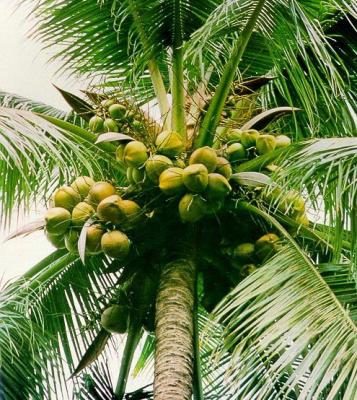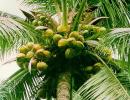
|
Coconut
Scientific name:
Cocos nucifera
Order/Family:
Arecales: Arecaceae
Local names:
Mnazi (Swahili)
Pests and Diseases:
African palm weevil
African rhinoceros beetle
Bud rot
Coconut bug
Coconut mite
Lethal bole rot
Lethal yellowing
Mealybugs
Rodents
Scales
Sedges
Termites
|
African palm weevils (Rhynchophorus phoenicis)
Adults are large weevils (40-55 mm in long), with a long snout and reddish brown in colour, and generally with 2 reddish bands on the thorax. Females lay eggs on wounds of various origins, on the mature stem as well as in the crown. Upon hatching the larvae (grubs) penetrate into the living tissues of the palm, feeding on the shoot and young leaves, where the insect completes its development in about 3 months. The damaged tissues turn necrotic and decay. Sometimes the grubs feed on the growing point killing the palm. Grubs are whitish-yellow, legless, and oval in shape; their head is reddish brown, and is armed with strong mandibles. Fully-grown grubs are 50 to 60 mm long. The pupal stage is passed within a cocoon of vegetal debris made by the grub at the end of its development. The African palm weevil usually damages young palms, yet may also, in exceptional cases, cause damage to mature crops.
The primary means of control for African palm weevil is preventative, using cultural and sanitary methods.
- Avoid wounds during plantation management. Adults are attracted to the odour of feeding sites and to injured palms, in which they lay their eggs.
- Remove all heavily attacked and wounded palms, along with those showing distinct growth disorders.
- Trap weevils. Traps made from thinned or wild palms that have been felled and split into longitudinal sections divert weevils away from cultivated palms, because adults are attracted to the chemicals emitted from damaged wood. Trap- heaps are frequently burnt and replaced with fresh trap wood. Burn trap- heaps frequently and replace them with fresh trap wood. Older traps can be sprayed with palm sap to maintain their effectiveness.

© Chayopak Taweesak (EcoPort, www.ecoport.org)
The African rhinoceros beetle (Oryctes monoceros)
It is a stout beetle, about 3.5 to 5 cm long, shiny dark brown to black in colour with a curved horn on the head, hence its common name. The adult flies at night to palms and bore into the hearth of the palms spear, chewing and cutting the youngest unopened leaves and the vegetative bud.
Attacked leaves continue to develop and unfold showing a characteristic V-shape damage.
If the whole growing point is eaten, the palm usually dies, particularly young palms less than four years old. The boreholes are often marked with a bundle of fibres pushed out of the hole by the beetle. This beetle is a serious pest in plantations where field sanitation is neglected. Eggs are laid in rotting plant material, especially dead palm trunks, compost heaps and rubbish dumps. The larvae (grubs) and pupae develop in rotten coconut logs and other decaying material.
- Fell, chop and remove dead palms to eliminate breeding sites.
- If logs cannot be removed, check the decaying end. Collect and destroy grubs.
- Hook out beetles in young palms. A 30 cm long iron rod with a hook at one end is pushed into the tunnel bored by the beetle while feeding. If the beetle is still inside it will be hooked out.
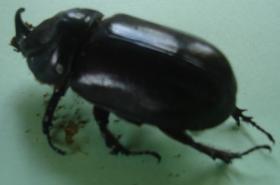
© Z. Seguni, MARI, Tanzania

Rhinoceros…

Rhinoceros…

Rhinoceros…

Rhinoceros…

Iron rods
Bud rot (Phytophthora palmivora)
Bud rot (also called heart rot) caused by the fungus Phytophthora palmivora has an extensive host range of more than 200 plant species and it is widespread in the tropics including tropical Africa. The fungus enters into the plant by infecting tender host tissues (leaves, buds or young nuts). Affected leaves turn yellow and later brown.
The heart leaf becomes chlorotic, wilts and collapses. The disease may spread to older, adjacent leaves and spathes, producing a dead centre with a fringe of living leaves. Light brown to yellow, oily, sunken lesions may be found on leaf bases, stipules or pinnae. Internally, the tissues beneath the bud are discoloured pink to purple with a dark brown border. Affected leaves progressively drop. Infected nuts show brown to black necrotic areas with a yellow border developing on the surface; internally, they have a mottled appearance. Young nuts are highly susceptible and fail to mature, they then fall off the tree; older infected nuts ripen normally.
- Remove and destroy infected debris and infected coconut trees. This helps to reduce spread.
- Do not irrigate nurseries at dusk or at night to avoid prolonged periods of free moisture.
- Plant resistant varieties. Malaysian dwarf varieties, such as "Malayan Yellow Dwarf", "Bali" "Tall", "Malayan Yellow Dwarf" x "Palu Tall" hybrids, and other varieties originating in South-East Asia, show resistance.
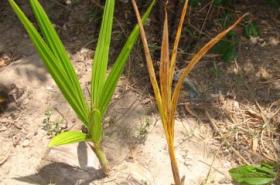
© Z. Seguni, MARI
Adult coconut bug (Pseudotheraptus wayi)
The coconut bug (Pseudotheraptus wayi) is the most important pest of coconuts in East Africa. A related species of coconut bug, Pseudotheraptus devastans, causes similar damage to coconuts in West Africa.
Adult bugs are brown in colour and 1.2 to 1.4 cm long. They lay eggs singly on the flowers or young nuts. Nymphs are red brown to green brown in colour and have long antenna. Adults and nymphs suck on flowers and developing fruits causing flower abortion and early nutfall. The toxic saliva of the bugs causes necrotic sunken lesions (scars) and cracks on the nuts.
Attacked young nuts excrete gum. Many of the attacked young nuts fall off. Nuts older than 3 months at the time of attack may not be aborted but remain small and have scars. Yield losses are difficult to assess since many of the nuts (over 70%) fall naturally. Nuts which abort naturally, do not show scars or gummosis. Two bugs per palm can cause considerable damage. Damage is usually less serious in intercropped coconuts. The bugs also feed on cashew, mango, cocoa and guava.
The predatory red weaver ant is an efficient natural enemy of the coconut bug. Weaver ants build nests on palms and other trees by joining leaves with silk produced by their larvae. They forage on the canopy chasing away or killing coconut bugs. Palms with weaver ants are usually free of damage by the coconut bug. Good control is achieved when more than 60% palms are occupied by thriving colonies of weaver ants. Unfortunately other ants present in coconut plantations fight weaver ants, and themselves do not protect (or not as effective as weaver ants) the palms against coconut bugs. These ants such as big headed ant (Pheidole megacephala), the crazy ant (Anoplolepis custodiens), and the long legged ant (Anoplolepis longipes) among others, kill or displace weaver ants, as a result palms are severely damaged. These competing or antagonistic ants need to be managed to allow weaver ants to do their beneficial work.
- Keep bushes and trees that are hosts for weaver ants in the surrounding of coconut fields.
- Intercrop coconuts with plants favoured by weaver ants such as citrus, soursop, guava, mango, etc
- In areas where the big headed ant is dominant keep ground vegetation. If there were no ground vegetation this ant would be forced to search food on the trees and would displace weaver ants.
- Connect the canopy of neighbouring palms/trees with sticks, wire, or ropes. Weaver ants can easily walk among trees searching for food and set up new nests avoiding other ants active on the ground.
- Where weaver ants are not present transfer weaver ant nests into the field by collecting nests from bushes around and placing them onto coconut palms or other host plants in the field. Care should be taken not to mix ants from different colonies since they would fight. Do not place nests collected from different trees or trees far apart on the same trees since they are likely to belong to different colonies and will kill each other. The best time for collection of nests is during the rainy season, since in this period many new queens are present in the ant nests, and these may get established in the orchard and start new colonies. Ants in nests introduced without the queen will die out after some time (they may live up to 8 months) and new introductions are needed.
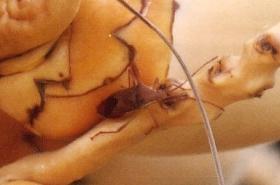
© B. Loehr, icipe

Coconut bu…

Coconut bu…
The coconut mite (Aceria (=Eriophyes) guerreronis)
This mite is tiny and difficult to see with the naked eye. When very many mites are together they appear as fine whitish dust. The coconut mite attacks and damages the upper part of the nutlets under the sepals of up to 6 months old nutlets. Attack is severe during the dry season. Attacked nuts may fall or have a scarred husk, which often splits. The nuts of coconuts showing light scarring on the husk are not seriously affected but in heavily scarred nuts there is significant damage to the nuts.
- Remove mature and prematurely fallen nuts. Although few mites are normally found on old bunches, they could rapid colonise young bunches.
- Provide balanced fertilisation to the palms. Mite damage seems to increase with increasing levels of nitrogen, and decreases with potassium. This suggests that the addition of N fertiliser could worsen the mite problem. However, the increased yield from fertiliser input could offset any increased loss due to worsened mite attack.
- Spray young bunches with sulphur (wettable sulphur at high dosage of 0.5%)
- Spray neem kernel extracts. Reportedly neem extracts are effective against this mite. For more information on neem click here.

© A. M. Varela, icipe
Lethal bole rot (Marasmiellus cocophilus)
In East Africa, Marasmiellus cocophilus causes death of palms up to 8 years old, seedlings being highly susceptible on transplanting to the field. Root infections occur, leading to decay of basal tissues and finally a rot of the spear leaf. On older palms, the first symptoms are a general wilt of the fronds, which remain as a 'skirt' around the trunk. The spear leaf dies and a foul-smelling soft rot develops at the base of the leaves. A dry, reddish-brown rot with a yellow margin is typically present at the base of the bole. Cavities within these areas of rot are lined with mycelium (fungal growth) in young palms, 2-4 years old, but rare in 4-6-year-old palms, and absent in mature palms.
Fungal bodies (like small mushrooms) commonly occur on exposed roots, leaf bases of seedlings, exposed tops of seed nuts and on the soil surface around holes (growing from coconut debris) where diseased palms had been removed 2 years previously. On average, there is only about 8 weeks from the time of onset of symptoms till the death of the palm; this interval depends on the extent of fungal decay in the bole.
Spread occurs through soil, root contact between palms, infected coconut debris and probably by airborne basidiospores (fungal spores). Infection also occurs via wounds.
- Uproot and burn affected palms immediately after detection of the disease.
- Replant with healthy seedlings. This will be successful only if the infested soil is treated.
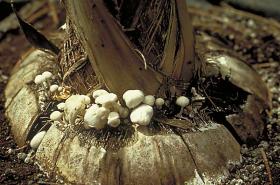
© Grahame Jackson (EcoPort, www.ecoport.org)
Lethal yellowing (Phytoplasma)
Symptoms include necrosis of inflorescences, yellowing of leaves and premature shedding of all fruit (nut fall) regardless of their developmental stage. Aborted nuts often develop a brown-black calyx-end rot reducing seed viability. Premature nut fall is accompanied or followed by inflorescence necrosis. This symptom is most readily observed as newly mature inflorescences emerge from the spathe. Normally light yellow to creamy white in colour; affected inflorescences are instead partially blackened (necrotic) usually at the tips of flower spikelets.
As disease progresses, additional emergent or unemerged inflorescences show more extensive necrosis and may be totally discoloured. Such symptom intensification results in the death of most male flowers and an associated lack of fruit set. Yellowing of the leaves usually starts once necrosis has developed on two or more inflorescences and discolouration is more rapid than that associated with normal leaf senescence. Yellowing begins with the older (lowermost) leaves and progresses upward to involve the entire crown. Yellowed leaves turn brown, desiccate and die. In some cases, the advent of this symptom is seen as a single yellow leaf (flag leaf) in the mid-crown. Affected leaves often hang down forming a skirt around the trunk for several days before falling.
A putrid basal soft rot of the newly emerged spear (youngest leaf) occurs once foliar yellowing is advanced. Spear leaf collapse and rot of the apical meristem invariably precedes death of the palm at which point the crown topples away leaving a bare trunk. Infected palms usually die within 3 to 6 months after the appearance of the first symptoms.
Lethal yellowing symptomatology may be complicated by other factors. For example, non-bearing palms lack fruit and flower symptoms. Foliar discolouration also varies markedly among coconut ecotypes and hybrids. For most tall-type coconut palms, leaves turn a golden yellow before dying whereas on dwarf ecotypes leaves generally turn reddish to greyish-brown.
Phytoplasmas are transmitted in a persistent (circulative-propagative) manner primarily by insect vectors belonging to the families Cicadelloidae (leafhoppers) and Fulgoroidae (planthoppers).
- Use genetically resistant ecotypes ("Malayan Yellow Dwarf") and hybrids ("Malayan Yellow Dwarf" x "Panama Tall"). This is the only practical long-term solution to lethal yellowing.
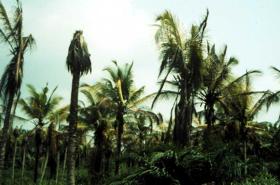
© B. Loehr, icipe

Lethal yel…

Lethal dis…
Mealybugs
Mealybug infestations of above-the ground plant parts start with the appearance of crawlers (the first- instar nymphs) on the underside of the leaves on terminal shoots, stems and other plant parts. Heavy mealybug attack appears as white, waxy masses of mealybugs on stems, nuts and along the veins on the underside of leaves. Heavy infestations usually result in coating of adjacent stems, leaves and nuts with honeydew and sooty mould. Severely infested plants may wilt due to sap depletion; leaves turn yellow, gradually dry and ultimately fall off. Feeding on nuts results in discoloured, bumpy, and scarred nuts, with low market value, or unacceptable for the fresh fruit market.
- Conserve natural enemies. Mealybugs are usually controlled by a wide range of natural enemies. However, use of pesticides may kill these natural enemies leading to mealybug outbreaks.
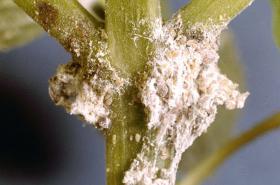
© Courtesy EcoPort (http://www.ecoport.org): Clemson University - USDA Cooperative Extension Slide Series
Rodents
In coconut palm monocultures, rodents, and especially rats, can develop into a serious epidemic, which is then difficult to bring under control again.
- Affix metal plates to the trunks to stop rodents from climbing up the trees.
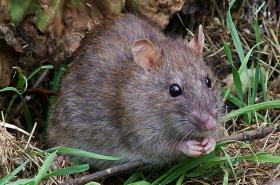
© Reg Mckenna, wikipedia
The coconut scale (Aspidiotus destructor)
A number of scales feed on leaves and fruits of coconut palms. The most damaging is the coconut scale (Aspidiotus destructor). This scale is bright yellow and round (females) or reddish and oval (males) covered with a semitransparent greyish white flat scale. The scale diameter is 1.5 to 2.0 mm. Females are always wingless and remain under their scale their entire life. Adult males have one pair of membranous wings, move about actively in search of females and do not feed during the adult stage. Eggs are protected underneath the scale or shell of the mother insect until they hatch. Upon hatching the young scales leave the maternal scale, take up a position and start feeding. They do not move afterwards. They are found mainly on the undersides of the leaves, but frond stalks, flower clusters and young nuts can also be attacked.
A severe infestation of this armoured scale forms a continuous crust over flower spikes, young nuts and the lower surface of leaves. The leaves become yellow and eventually die. The crown dies leading to collapse of the infested plant. Attacks of young nuts cause shrivelling of nuts leading to premature nut falls. Mostly young coconut trees of up to 10-15 years are vulnerable to damage.
Scales may infest palms throughout the year, but damage is usually more severe during the dry season. Neglected plantations are particularly susceptible.
The coconut scale also attacks many species of fruit trees, such as avocado, breadfruit, mango, guava and papaya. Other major hosts are cocoa, cassava, cotton, oil palm, papaya, rubber, sugarcane and tea. It also attacks a range of ornamental plants including roses.
- Conserve natural enemies. They usually keep scales under control. Ladybird beetles and parasitic wasps are particularly effective in controlling the coconut scale
- Avoid or restrict movement of infested plants in areas where the coconut scale is not a problem, to avoid spread of the scale.
- Destroy infested plants and plant parts. This may help to eradicated scales from new areas. However, this scale is difficult to eradicate due to its wide host range.
- Provide good growing conditions for the palms. Healthy palms in well-drained soils are seldom seriously infested.
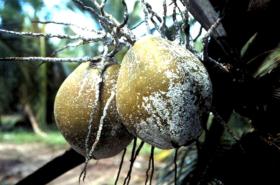
© B. Loehr, icipe

Coconut sc…

Coconut sc…
Termites (Coptotermes formosanus)
Termites can be a serious problem for coconut palms, particularly for young trees in tree nurseries or trees that have just been transplanted into the field. Termites live in the soil in hills, construct tunnel from the hills to the palms and feed on all parts of young coconut palms. Damage occurs mainly during the dry season.
Many plants have a repellent or even insecticidal effect on termites and can be applied as spray directly against termites or as barrier around the trunk of coconut palms:
- Neem: seeds and leaves (extracts or cake)
- Quassia indica or Q. amara: bark and leaves
- Sandalwood: wood
- Chinaberry, persian lilac (Melia azedarach): bark, branches, leaves, extracts
- Euphorbia sp.: "In Tanzania, especially in Dar es Salaam and coast regions, farmers plant with each seedling 2 or 3 sticks of Euphorbia sp. to protect the young palms from termite attack. On nurseries the Euphorbia plants can be planted around the seedbed to prevent access of termites to the palm seedlings and young palms. When the palms have grown big the euphorbia is simply cut down. The practice is widespread and farmers are convinced that it really does keep termites off the susceptible seedlings ( Z. Seguni, MARI personal communication)".
- Place nurseries in land without termites.
- Alternatively, raise palms in polyethylene bags and check them always for termites.
- Pour a thin layer of sand from the soil over the exposed parts of the buried nuts.
- Help termite enemies (birds, insect predators) to have close habitats by the above mentioned diversification strategies.
- Traditional methods for controlling termites include: flooding mounds, digging out mounds and removing the queens, suffocating the colony by burning

© A. M. Varela, icipe

Termites

Coconut se…
| General Information and Agronomic Aspects | Information Source Links | |||
| Information on Diseases | Contact Information | |||
| Information on Pests |
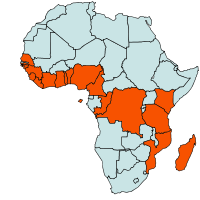 |
| Geographical Distribution of Coconut in Africa |
The coconut palm is an important tree in most tropical islands and along the coastal regions of tropical Africa. It is a multipurpose tree. Every part of the coconut palm can be used. The juice from the inflorescence, which can contain up to 15% sugar, is used to make palm-wine. Half-ripened nuts (6-7 months old) are often eaten fresh. The juice can be drunk, and milk is squeezed out of the meat (endosperm). Fully ripened nuts (after 11-12 months) provide the so-called copra, which is made from the firm meat of the nut.
Copra is high in oil and protein content (65% oil, 25% protein). Coconut oil is produced from drying and pressing the copra. Grated coconut is made from fresh copra. The hard coconut shells are used to make charcoal. When they have been finely grated, coconut shells are used as fillers for objects made of plastic, such as buttons, containers and other objects. Coconut fibres are used in the upholstery industry, to make ropes, as mulching material or as a substitute for peat. The leaves and wood are used as building material and to make household objects (e.g. baskets, brooms) and tools.
Nutritive Value per 100 g of edible Portion
| Raw or Cooked Coconut | Food Energy (Calories / %Daily Value*) |
Carbohydrates (g / %DV) |
Fat (g / %DV) |
Protein (g / %DV) |
Calcium (g / %DV) |
Phosphorus (mg / %DV) |
Iron (mg / %DV) |
Potassium (mg / %DV) |
Vitamin A (I.U) |
Vitamin C (I.U) |
Vitamin B 6 (I.U) |
Vitamin B 12 (I.U) |
Thiamine (mg / %DV) |
Riboflavin (mg / %DV) |
Ash (g / %DV) |
| Coconut meat dried | 660 / 33% | 23.7 / 8% | 64.5 / 99% | 6.9 / 14% | 26.0 / 3% | 206 / 21% | 3.3 / 18% | 543 / 16% | 0.0 IU / 0% | 1.5 / 2% | 0.3 / 15% | 0.0 / 0% | 0.1 / 4% | 0.1 / 6% | 1.9 |
| Coconut meat raw | 354 / 18% | 15.2 / 5% | 33.5 / 52% | 3.3 / 7% | 14.0 / 1% | 113 / 11% | 2.4 / 13% | 356 / 10% | 0.0 IU / 0% | 3.3 / 5% | 0.1 / 3% | 0.0 / 0% | 0.1 / 4% | 0.0 / 1% | 1.0 |
| Coconut water | 19.0 / 1% | 3.7 / 1% | 0.2 / 0% | 0.7 / 1% | 24.0 / 2% | 20.0 / 2% | 0.3 / 2% | 250 / 7% | 0.0 IU / 0% | 2.4 / 4% | 0.0 / 2% | 0.0 / 0% | 0.0 / 2% | 0.1 / 3% | 0.4 |
| Coconut milk raw | 230 / 12% | 5.5 / 2% | 23.8 / 37% | 2.3 / 5% | 16.0 / 2% | 100.0 / 10% | 1.6 / 9% | 263 / 8% | 0.0 IU / 0% | 2.8 / 5% | 0.0 / 2% | 0.0 / 0% | 0.0 / 2% | 0.0 / 0% | 0.7 |
| Coconut Vegetable Oil | 862 / 43% | 0.0 / 0% | 100.0 / 154% | 0.0 / 0% | 0.0 / 0% | 0.0 / 0% | 0.0 / 0% | 0.0 / 0% | 0.0 IU / 0% | 0.0 / 0% | 0.0 / 0% | 0.0 / 0% | 0.0 / 0% | 0.0 / 0% | 0.0 |
Coconut needs a continuous supply of water, which can be provided by regular rainfall of about 1250 mm per annum, or from ground water (at a depth of 1-3 m). It can not tolerate water logging. The northern Kenya coast receives only a rainfall of 750-1000 mm and this restricts production. Coconut grows best at average temperatures of around 26-27°C. Because of its temperature requirements, the coconut palm cannot normally grow above 750 m. However, near to the equator and in areas where other conditions are favourable for coconut development, it is possible to grow the crop up to about 1300 m. Growth is stimulated by a sufficient supply of chlorine in the soil. The coconut palm can withstand up to 1% salt in the soil.
These conditions are generally found in tropical and subtropical coastal regions with little rainfall. Coconut palms can also grow on deep, water-logging free, alluvial soil, away from the coast - yet low chlorine content in the soil could have negative effects. Consider these conditions when choosing a site.
Depending on the site, coconut palms can be cultivated on agroforestry systems. As a plant of the upper storey, with essential light requirements, the coconut palm towers above such crops as citrus, cacao and others.
The quality of the seeds is important for the forthcoming yield from the palm. For this reason, the seeds should originate from a healthy, productive stock plant. Usually, the seedlings are raised in state and private tree nurseries. If no tree nursery can be found which comply with the requirements of organic cultivation, then the seedlings will have to be raised on the site.
Two different main groups are cultivated in the commercial sector: the tall plants of the Typica group, which generally need to be cross-fertilised, and dwarf types of the Nana group, where self-pollination is the norm. Tall varieties should always be chosen for agroforestry systems, because they can reach up to the upper levels intended for them, and thus fully develop. Dwarf palms grow very slowly, and are easily overshadowed in the system, hindering their full development. In addition, the Nana variety reacts more sensitively to drought and some diseases than Typica varieties.
Three distinct types grow in Kenya: the "East African tall", the "Pemba Dwarf" and hybrids. The following hybrids have been introduced to increase yields and quality of coconut in Kenya:
- "PB 121" ("Malayan Yellow Dwarf" x "West African Tall")
- "A72" ("Green Dwarf" x "West African Tall")
- "Tahiti Tall" x "West African Dwarf"
- "Yellow Dwarf" x "Tahiti Tall"
- "Reussell Tall" x "West African Tall"
The hybrid "PB 121" has shown to be particularly high yielding (Griesbach, 1992).
Before sowing, the nuts are sorted; use only those nuts containing water. Cut away the shell on the germinating side of the nut to facilitate germination, and soak the nuts in water for 14 days, before sowing them in loose soil that can drain easily. Lay the nuts lengthways in the soil with the upper side visible. Sow nuts in nursery beds at a distance of 45 cm. Use coconut fibres as mulching material between the rows leaving the planting area uncovered.
On smallholdings, the nuts are often merely set out in shaded areas, lightly dug in, and then covered over with organic material.
Planting methods
Nuts usually begin to germinate after 12 weeks in the nursery beds. There, they require no additional fertiliser, as the endosperm provides them with sufficient nutrients. When the seedlings are planted in beds dry season, then the beds need to be irrigated 2 times a week with around 5 l water/m². Select the strongest seedlings after the 5th month and label them for transplanting. Around 20-40 % of the seedlings will be unusable. Suitable seedlings germinate earlier, and have thicker leaf bases. Early leaf-development is a sure sign of a strong plant. Transplant seedlings after 9-10 months, by that time they should have developed 4-5 fully opened leaves. Remove seedlings from the nursery beds, shorten their roots, and plant again as soon as possible.
The distances between the plants should be between 7.5 x 7.5 m and 6 x 9 m, depending on the cultivation method used and the other crops being grown, or similar distances resulting in an average density of 150-180 trees/ha. The recommended normal spacing for tall hybrids is 8 x 8 m or 9 x 9m, and for dwarf hybrids 7 x 7 m. The planting holes should be about 60 cm deep and 60 cm in diameter. The planting hole should be dug at least 1 month before planting and immediately filled with a mixture of topsoil, wood ash and well-rotted manure which is allowed to settle. Transplanting should be done at the beginning of the rains. Place the plant in the hole about 30 cm below the soil level. Fill the remaining space in the hole gradually as the palm becomes bigger. By using this planting method the palms are less susceptible to drought. This method should not be used when the ground water is relatively high. The nut should be earthed up only to the collar of the shoot to avoid soil entering the leaf axils.
The young seedlings need to be protected from animals (cattle and other livestock)
If possible large plants should be used from the nursery beds when setting up agroforestry systems including coconut palms. This applies not only to coconut palms, but also to all types of palms integrated within agroforestry systems. Coconut palms will grow on any sites that are suitable for cacao, bananas, citrus (oranges) or papaya. On citrus plantations, a slightly lower density should be used (120-150 plants/ha) than for cacao (150-180 plants/ha).
Three phases can be identified in the development (life cycle of the coconut palm) of the crop:
| Life cycle | Shade | Mixed crops |
| 1st phase: up to 8th year | A full frond will only have developed after 8 years; during this time, only partial shade is available | Cultivation of annual crops possible. |
| 2nd phase: from 8-25thyear | Comparatively large amount of shade | Cultivation of shade-tolerant varieties |
| 3rd phase: older than 25years | Shade reaching to the ground diminishes as trees attain full height | High amounts of sunlight allows cultivation of plants needing lots of light. |
The compost is spread out in a circle 3-5 m underneath the palms, and preferably covered over with coconut shell mulching material. The latter may be especially necessary in systems lacking enough additional vegetation.
A deficiency in potash will result in a large reduction of yield for coconut palms. The vast majority of the potassium is thereby contained in the fruit water of the coconuts. On cultivation systems which include cacao, returning the cacao shells to the site will supply sufficient potassium to balance out the extraction. The continual pruning of crops on diversified agroforestry systems provides an important source of nutrients (potassium).
When providing a nutrient supply to coconut palms, it should be noted that it can take up to 36 months before inflorescence begins. This means that measures to supply nutrients, or to counteract deficits or other morphological disturbances, will take 3 years before they have an effect on production.
Due to their symbiosis with endomycorrhizae fungi (phosphate supply), and their tolerance of soil salts (which are often harmful to the other crops), coconut palms, as well as other varieties of palms, have a beneficial effect on the growth of the other crops in an agroforestry system.
Keep area around the tree free of weeds. Coconut will suffer from too much competition from weeds and bush regrowth. Recommended weed control methods include slashing by hand or grazing by cattle. Avoid weeding with mechanical implements as these can damage the roots of the tree. The economic life of a coconut tree is about 25-30 years. After this period, the low producers, dead and diseased trees should be removed from the field and replaced with new seedlings.
Copra drying
- Sun drying
Remove the husk first. Dry nuts on a clean surface to reduce moisture from 45% to 6%. In fine weather this takes about 5 days. Turn the pieces occasionally and cover them at night and in rainy weather. - Kiln drying
Make a fire in the pit of the kiln. Use the coconut shells as fuel as they heat well and smoke little. Put the copra on a wire mesh platform over the fire and protect it from the rain. This takes about 4 days.
Most of the problems concerning disease and pests have the following causes:
- Cultivation in a monoculture, or with too few different varieties.
- Too little distance between species that grow to the same height; failure to trim agroforestry systems.
- Degenerated or poor soil, lacking organic material.
- Unsuitable sites (water-logging, too dry, soil not deep enough for roots).
In most cases, the most effective cure is to alter the entire system of cultivation. If a system is not yet in a state of ecological equilibrium, bud rot or heart rot, caused by Phytophthora palmivora, can occur in all of the producing regions - where it is widely spread. In cases of heavy infestation with Phytophtora palmivora, harvest-losses can be lessened by using Bordeaux mixture, or any other copper-rich spraying preparations, which are permitted in organic farming systems. These measures should only be undertaken in cases of emergency. In less severe cases, removing any infested plants from the plantation will result in the infection being limited. Amongst the young trees in tree nurseries, an attack of termites may occur. The termites can be effectively combated by pouring a thin layer of sand from the soil over the exposed parts of the buried nuts. Young coconut palms are also susceptible to the rhinoceros beetle and coconut caterpillars. Pheromone traps have been successfully utilised in Sri Lanka against the rhinoceros beetle. In emergency cases, butterfly caterpillars can be regulated with Bacillus thuringiensis (Bf).
The trunks of young seedlings are often protected against pests by painting them with tar. This is not allowed an organic plantations, and the black covering also causes the plants to heat up unnecessarily. An alternative is to paint the trees with a mixture of sulphur, soil and lime, (1 : 2 : 1) added together with water to make a thick paste. If necessary, the paste may need to be renewed, as rain will wash it off.
Coconut red weevil and Rhinocerus beetle only usually damage young palms, yet may also, in exceptional cases, cause damage to mature crops. In acute cases, they can be combated by closing the larvae tunnels, and with pheromone traps.
In coconut palm monocultures, rodents, and especially rats, can develop into a serious epidemic which is then difficult to bring under control again. Metal plates affixed to the trunks will effectively stop them from climbing up the trees.
|
The coconut mite (Aceria (=Eriophyes) guerreronis) This mite is tiny and difficult to see with the naked eye. When very many mites are together they appear as fine whitish dust. The coconut mite attacks and damages the upper part of the nutlets under the sepals of up to 6 months old nutlets. Attack is severe during the dry season. Attacked nuts may fall or have a scarred husk, which often splits. The nuts of coconuts showing light scarring on the husk are not seriously affected but in heavily scarred nuts there is significant damage to the nuts. | 
Coconut mite damage
Nuts damaged by the coconut mite (Aceria (=Eriophyes) guerreronis) © A. M. Varela, icipe |
|
What to do:
|
- Anon. (1990). Hypothesizing about palm weevil and palm rhinoceros beetle larvae as traditional cuisine, tropical waste recycling, and pest and disease control on coconut and other palms... can they be integrated? The Food Insects Newsletter, 3(2):1-4.
- Bohlen, E. (1973). Crop pests in Tanzania and their control. Federal Agency for Economic Cooperation bfe. Verlag Paul Parey. ISBN: 3-489-64826-9.
- CAB International (2006). Crop Protection Compendium, 2006 Edition. Wallingford, UK www.cabi.org
- Field Crops technical Handbook (2002). Agricultural Information Centre, Nairobi Kenya
- Griesbach, J. (1992). A Guide to Propagation and Cultivation of Fruit Trees in Kenya. Schriftenreihe de GTZ, No. 230. Published by Technical Cooperation- Federal Republic of Germany (GTZ). ISBN: 3 88085 482 3
- Hill, D. (1983). Agricultural insect pests of the tropics and their control. 2nd Edition. Cambridge University Press. ISBN: 0-521-24638-5.
- Integration of Tree Crops into Farming Systems Project & Ministry of Agriculture and Rural Development, Kenya (2000). Tree Crop Propagation and Management - A Farmer Trainer Training Manual.
- Kessing, J.L.M., Mau, R.F.L. (2007). Crop Knowledge Master. Coconut scales Aspidiotus destructor. Updated by: J.M. Diez April 2007. www.extento.hawaii.edu
- Naturland e.V. (2000). Organic Farming in the Tropics and Subtropics. Exemplary description of 20 crops. Coco palms. www.naturland.de
- Nutrition Data www.nutritiondata.com.
- Pest of the Month. Coconut Scale Insect Aspidiotus destructor Signoret (Hemiptera:Dispididae). www.spc.int
- Van Mele, P., Cuc, N. T.T. (2007). Ants as friends. Improving your tree crops with weaver ants. (2nd Edition). Africa Rice Center (WARDA), Cotonou, Benin and CABI, Egham, U.K. 72 pp. ISBN: 92-913-3116.
- Varela, A. M. (1993). Studies on the distribution and importance of the coconut mite Eriophyes guerreronis Keifer, as a pest of coconut palms in Tanzania. Internal report. National Coconut Development Programme (NCDP).
- Varela, A. M. (1997). Establishment of Oecophylla longinoda Latreille (Formicidae), a predator of the coconut bug Pseudotheraptus wayi Brown (Coreid) in new areas in Tanzania. Proceedings of the International Cashew and Coconut Conference, Dar es Salaam. Pp 442-446.
- Way, M. J., Khoo, K. C. (1992). Role of ants in pest management. Annual Review of Entomology. Vol 37: 479-503.
- KARI Mtwapa (karimtw@gmail.com; +25441486207)
- KARI Muguga (narcmuguga@africanonline.co.ke +25466328801)

 Back
Back
